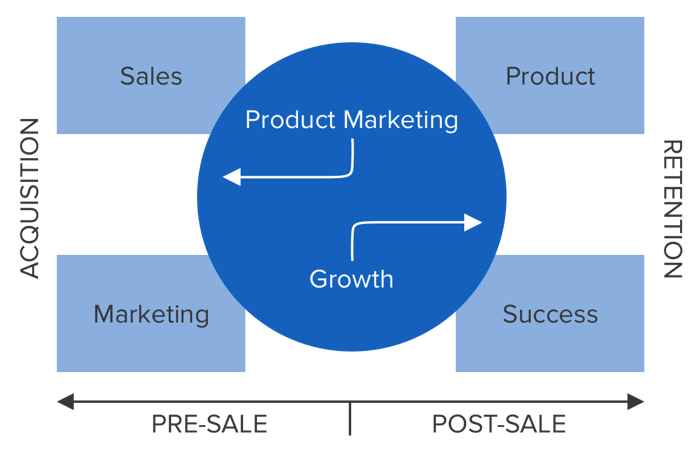If there is a role in modern businesses that is less understood than Product Marketing, it is Growth. What’s more, both roles become more confusing because they often sit in similar pockets in the org chart. There are some overlaps and distinctions between the fields of Growth and Product Marketing, as well as many opportunities for these professionals to work together.
Why Growth?
Growth roles have become more common over the past few years, particularly in technology companies, in parallel with a larger movement toward product-led growth. What started as an ill-defined idea of “growth hacking” focused on experimentation and shortcuts has transformed into a more mature role with more structure.
The idea of a Growth role gained prominence thanks to some high profile initiatives by business-to-consumer (B2C) companies like Airbnb that captured huge audiences in short order and constructed new in-app experiences to convert them into customers. This viral success was soon eyeballed by business-to-business (B2B) players as a potential way to accelerate customer acquisition.
Rather than employ traditional sales and marketing acquisition strategies, companies explore a shift in product strategy to create free or low-cost offerings that get new customers in the door. This method radically reduces customer acquisition cost (CAC) that typically was driven by big investment in large customer-facing teams and unpredictable paid marketing channels. Of course, after getting customers into a lower tier of the product, the product focus then shifts to conversion-driven experiences to offer upgrades to higher value paid features and capabilities.
The Different Goals of Product and Growth
With that context on the fast rise of Growth roles, we can pivot to look at where these roles typically live in organizations, which is strikingly similar. Product Marketing and Growth both connect the R&D and commercial teams in companies, enabling both to drive more value to the market and generate revenue.
One key distinction is that Product Marketing tends to focus more on creating value pre-sale, while Growth tends to focus more on post-sale value creation. These dynamics can vary from company to company based on business model and product type, but the dichotomy is common. As a result, Product Marketing tends to align more closely with acquisition-oriented teams like Sales and Marketing, and Growth tends to partner with retention-driven teams like Product, UX/Design, and Customer Success.

A second distinction involves the methodology of how to create value. Product Marketers often operate from a “story-first” mindset, whereas Growth pros lean towards a “user-first” one. Product Marketers start with buyers to create a narrative about the company and its products. Most of their work from messaging and positioning to go-to-market and launch planning derives from the stories that will resonate with the buyer. Growth begins with how users encounter the product. Understanding those patterns helps them identify opportunities to increase usage, satisfaction, loyalty, and new channels.
Neither would negate the power of story or user experience in their work, and in fact, these distinct lenses can make Growth and Product Marketing powerful partners. Combining the power of story and experience creates deep knowledge of an organization’s clients throughout their entire lifecycle, starting from the buying journey and running through the customer journey. As Growth becomes more established and Product Marketing becomes more data-driven, it seems likely that we will see a convergence of these teams in companies that are thinking about the customer experience holistically.
To add some further granularity to the distinctions, it is worth noting that both roles operate a bit differently in B2B and B2C environments. Thanks to simpler buyer/customer relationships, B2C companies often have Product Marketing teams that are smaller and focus more on messaging across the brand; Growth may operate as more of a commercial and business development arm of the product team. In B2B companies, Product Marketers are likely to have more complex buyer relationships to define and work deeper in the funnel to deliver value; Growth may have a more internal focus on customer retention and work closely with Product to find levers to pull to drive improved experiences that lead to long-lasting relationships with customers. These generalities can also blur or become irrelevant based on many factors, including business models like Business-to-Business-to-Consumer (B2B2C) or networks, complex or high-cost consumer products, and more.
How Each Role Sees the Market and Competition
Due to all of the factors already covered, Product Marketing and Growth tend to view moves by competition and the market differently. For Product Marketers, competitive intel and analysis combine with strong market knowledge to form their core narrative and keep it fresh. They are usually responsible for keeping various stakeholders like sales and executives up to date on the latest market trends and competitive moves. Sometimes, this expectation also extends to the Product team, and in progressive companies, the Growth team can be consumers of Product Marketing’s competitive and market intelligence as well.
While they need to stay informed of what competitors are doing, living closer to the user experience means that Growth professionals have a unique perspective. Feature updates and product capabilities that can drive roadmap priorities for Product could also distract from the best Growth solution for companies. Getting stuck in the trees can obscure big opportunities at the forest level. Growth pros also like to keep an eye on non-competitive spaces for companies with similar business models because awareness of clever solutions can spark an innovative approach that they can borrow. In this way, market intelligence for Growth is broader than just the immediate market space.
When they work closely together, Product Marketing and Growth can be essential partners in creating a coherent, accelerating go-to-market plan that drives new and existing business. Their point of views are ultimately complementary – each strengthening the other’s ability to deliver. In time, we may see a convergence of these roles into a full-lifecycle customer-facing team that understands how to speak to the market, how to measure success, and how to translate both into greater impact on the bottom line.
Until that convergence, Product Marketers in companies without Growth functions can examine if they should expand the scope to help impact their organization’s success. Whether working with R&D teams to access user data or focusing more on retention, both have the ability to drive happier, longer-term customers that naturally translate into more case studies and testimonials.

Related Blog Posts
Popular Posts
-
 The 8 Free Market Research Tools and Resources You Need to Know
The 8 Free Market Research Tools and Resources You Need to Know
-
 6 Competitive Advantage Examples From the Real World
6 Competitive Advantage Examples From the Real World
-
 How to Create a Competitive Matrix (Step-by-Step Guide With Examples + Free Templates)
How to Create a Competitive Matrix (Step-by-Step Guide With Examples + Free Templates)
-
 24 Questions to Consider for Your Next SWOT Analysis
24 Questions to Consider for Your Next SWOT Analysis
-
 How to Measure Product Launch Success: 12 KPIs You Should Be Tracking
How to Measure Product Launch Success: 12 KPIs You Should Be Tracking





